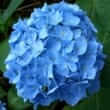Background
- Hydrangea is an ornamental plant native to North and South America and eastern and southern Asia. It has been used for the treatment of urinary tract disorders in traditional Chinese medicine and by the Cherokee tribe of North America.
- Preliminary study has investigated hydrangea for its potential antifungal, antimalarial, and blood sugar-lowering properties. When applied to the skin, hydrangea may prevent male pattern baldness.
- There is currently not enough human evidence available to support the use of hydrangea for any indication.
References
Natural Standard developed the above evidence-based information based on a thorough systematic review of the available scientific articles. For comprehensive information about alternative and complementary therapies on the professional level, go to . Selected references are listed below.
- Avenel-Audran M, Hausen BM, le Sellin J, et al. Allergic contact dermatitis from hydrangea--is it so rare? Contact Dermatitis 2000;43(4):189-191.
View Abstract - Bruynzeel DP. Contact dermatitis from hydrangea. Contact Dermatitis 1991;24(1):78.
View Abstract - Bruynzeel DP, Hausen BM. Allergic contact dermatitis to hydrangea. Contact Dermatitis 1987;16(3):181.
View Abstract - Bruynzeel DP. Allergic contact dermatitis to hydrangea. Contact Dermatitis 1986;14(2):128.
View Abstract - De Rooij J, Bruynzeel DP, Rustemeyer T. Occupational allergic contact dermatitis from hydrangea. Contact Dermatitis 2006;54(1):65-66.
View Abstract - Ishih A, Miyase T, Terada M. Comparison of antimalarial activity of the alkaloidal fraction of Hydrangea macrophylla var. Otaksa leaves with the hot-water extract in ICR mice infected with Plasmodium yoelii 17 XL. Phytother Res. 2003;17(6):633-639.
View Abstract - Kikuchi M, Kakuda R, Kikuchi M, et al. Three new glycosides from the leaves of Hydrangea macrophylla subsp. serrata (THUNB.) MAKINO. Chem Pharm Bull (Tokyo) 2008;56(4):610-611.
View Abstract - Kuligowski ME, Chang A, Leemreize JH. Allergic contact hand dermatitis from hydrangea: report of a 10th case. Contact Dermatitis 1992;26(4):269-270.
View Abstract - Matsuda H, Wang Q, Matsuhira K, et al. Inhibitory effects of thunberginols A and B isolated from Hydrangeae Dulcis Folium on mRNA expression of cytokines and on activation of activator protein-1 in RBL-2H3 cells. Phytomedicine. 2008;15(3):177-184.
View Abstract - Meijer P, Coenraads PJ, Hausen BM. Allergic contact dermatitis from hydrangea. Contact Dermatitis 1990;23(1):59-60.
View Abstract - Rademaker M. Occupational contact dermatitis to hydrangea. Australas J Dermatol. 2003;44(3):220-221.
View Abstract - Tsuji Y, Denda S, Soma T, et al. A potential suppressor of TGF-beta delays catagen progression in hair follicles. J Investig Dermatol Symp Proc. 2003;8(1):65-68.
View Abstract - Yang Q, Gong ZZ. Purification and characterization of an ethylene-induced antifungal protein from leaves of guilder rose (Hydrangea macrophylla). Protein Expr Purif. 2002;24(1):76-82.
View Abstract - Yoshida K, Ito D, Shinkai Y, et al. Change of color and components in sepals of chameleon hydrangea during maturation and senescence. Phytochemistry 4-16-2008;
View Abstract - Zhang H, Matsuda H, Kumahara A, et al. New type of anti-diabetic compounds from the processed leaves of Hydrangea macrophylla var. thunbergii (Hydrangeae Dulcis Folium). Bioorg Med Chem Lett. 9-1-2007;17(17):4972-4976.
View Abstract







